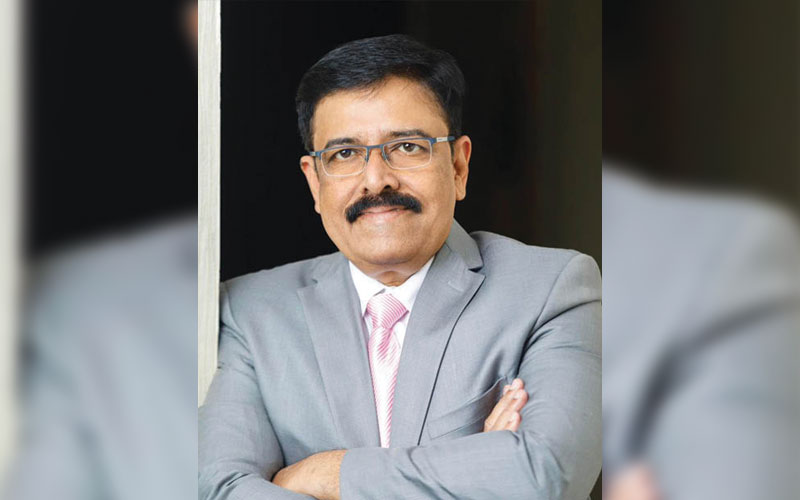Apar Industries has predicted robust growth for the wire & cable industry, especially in the solar segment, owing to various policies initiated by the Government of India, coupled with ample opportunities in the US markets. This was said by Mr. Shashi Amin, CEO (Cable Solutions), APAR Industries, during his recent interaction with the Wire & Cable India.

Wire & Cable India: How much has the Indian solar wire and cable segment evolved over the years, and how are you positioned as a manufacturer in it?
Shashi Amin: India aims to slash its projected carbon emissions by 45 percent by 2030 and achieve net-zero emissions by 2070. The goal includes reaching 500 GW of renewable energy capacity by 2030. With utilities now mandated under the Renewable Purchase Obligation (RPO) to increase renewable energy use, the cable sector anticipates supplying materials for the renewable energy sector, especially in solar segments. As announced by the Government of India, more than INR 75,000 crore have been allocated to enable solarization of one crore households under the Rooftop Solar Yojana. This initiative includes providing up to 300 units of free electricity per month for solar rooftop systems up to 3 kW capacity, along with easy and affordable loans at a lower interest rate. All these initiatives will make renewable energy adoption more accessible and cost-effective at the grassroot level. APAR Cable Solutions is the sixth largest player in the organized sector of the Indian cables and wires market with 8 percent market share. In terms of the last 5-year CAGR, we are among the fastest growing players in the industry. APAR has developed technologically-advanced, anti-rodent & anti-termite special PV wires for the solar industry with zero transmission loss, life expectancy beyond 25 years, RoHS compliance and UV resistance.
WCI: How significant is the solar segment for you? Please take us through your solar product portfolio.
SA: The solar segment holds critical significance for APAR Cable Solutions, where we maintain a leadership position. This sector is pivotal due to India’s rapid expansion in solar energy capacity, driven by ambitious renewable energy targets. This growth fuels a substantial demand for solar cables, crucial for connecting solar panels to the grid. We take pride in manufacturing a diverse range of indigenous solar cables and wires, leveraging advancements in technology to meet the evolving demands for efficiency, durability and capability to handle higher voltages and temperatures. The economic opportunities presented by the solar segment, characterized by large-scale projects and significant procurement needs, underscore the strategic importance in driving APAR Cable Solutions’ growth and enhancing our role in sustainable business practices.
APAR has introduced fire-retardant, UV-resistant, anti-rodent & anti-termite solar cables for emerging PV-based renewable energy installations ranging from 2.5 to 500 sq mm. Our solar cable portfolio further includes E-Beam irradiated LT XLPE cables suitable up to 120°C operating temperature with higher current rating; annealed tinned flexible copper conductor; E-Beam cross-linked polyolefin (XLPO) insulation and sheath having UV & ozone protection properties; and life span of more than 25 years. Our cables are halogen-free and can operate up to 120°C rated 1.5kV (max 1.8 kV). Our aluminum cables come with steel tape/flat strip/round wire armouring for combiner box to inverter. We provide nylon-jacketed cables as per AS/NZ specs for rodent protection. We have received international certification of the highest standards as per BS EN 50618, TUV 2007 & 2012, IEC 62930:2017 & UL 4703.
Watch: RR Kabel | Solar Cables | Solar Plant | Renewable Energy
WCI: Based on end-users, such as residential, industrial and commercial, where do your solar cables experience more demand? Why?
SA: The industrial segment experiences higher demand for solar cables due to various reasons, such as the project scale, high power specification, distinct requirements, compliance standards, and economic viability. Industrial solar projects often involve large-scale installations compared to residential or small-scale commercial projects. This translates into greater requirement for solar cables to connect numerous solar panels and arrays efficiently.
Industries typically have higher energy consumption needs. This necessitates robust and high-capacity solar cables capable of transmitting higher voltages and currents over longer distances without significant power loss. Industrial applications often demand specialized solar cables tailored to specific environmental conditions, such as extreme temperatures, UV exposure or mechanical stress.
Manufacturers must meet these requirements with cables designed for durability and reliability in industrial settings. Industries are also subjected to stringent regulatory standards and safety norms. Solar cables used in industrial settings must comply with these regulations, ensuring safety and reliability in operation. For many industries, investing in solar energy is not only a commitment to sustainability but also a strategic financial decision. As the cost of solar energy continues to decrease and government incentives promote renewable energy adoption, industrial sectors find solar installations increasingly economically viable. This drives the demand for high-quality and efficient solar cables to maximize the return on investment.
WCI: What technologies have you incorporated into your manufacturing facilities to produce solar wire and cable?
SA: APAR was one of the early movers adopting the E-Beam technology in 2012 in a big way and now has five state-of-the-art E-Beam accelerators. We are a leading manufacturer in the domestic segment for renewable sector cables. Our solar cables are irradiated by E-Beam cross-linking technology, which gives them life expectancy beyond 25 years. E-Beam processing utilizes high-energy electrons to induce chemical and physical changes in various materials through exposure to ionizing radiation. E-Beam curing increases heat resistance (C-C direct bonding), electrical properties (sustain higher temperature without degrading the material properties), insulating property (materials can sustain higher voltage with lower radial thickness) and life expectancy of cables compared to chemical curing.
WCI: Compared to other wire and cable, how different is the manufacturing process of solar wire and cables?
SA: APAR’s solar cables undergo a specialized E-Beam irradiation process, distinguishing them from standard cables primarily through unique compound formulation and the additional step of E-Beam treatment. In this process, electrons are accelerated to near light speed and then passed through a scanning device that directs them onto a high-speed conveyor system, where materials, including cables, are exposed to a curtain of high-energy electrons. This exposure causes the electrons to penetrate the sheath of the cables inducing cross-linking of polymer in a three-dimensional manner. Only a handful of Indian manufacturers have the E-Beam set up and license to operate.
WCI: How sustainable are your products? Please detail the process you have adopted to achieve it.
SA: APAR Industries Limited embarked on its sustainability journey in 2021, guided by the UN Sustainable Development Goals (SDGs). Since then, APAR has achieved significant milestones, including calculating GHG emissions, water footprint, and solid waste. APAR published its inaugural Environmental, Social, and Governance (ESG) report in 2021. By 2023, APAR joined CDP for disclosure, conducted employee training on environmental policies, and commissioned a wind-solar hybrid plant. The company also reduced GHG intensity, expanded renewable energy capacity and implemented water conservation measures, thus achieving an ESG score of 59 from CRISIL. APAR has done its sustainability disclosure to EcoVadis and also won a Silver medal from EcoVadis.
APAR Industries Limited prioritizes sustainability not only in its operations but also in its products and manufacturing processes. Through innovation and responsible sourcing, APAR integrates eco-friendly materials and designs that minimize environmental impact throughout the product life cycle. In manufacturing, APAR implements efficient processes and technologies to reduce energy consumption, waste generation, and carbon emissions.
Also Read: Polycab: One-Stop Photovoltaic Shop for All Major Components
WCI: Given India’s ambitious 500GW renewable energy target and solar wire & cable being the lifelines of the solar power system, what kind of growth prospects are you staring at?
SA: Given India’s ambitious target of achieving 500GW of renewable energy capacity, prospects for the wire & cable industry, especially in the solar segment, are highly promising. Solar cables are integral to the functioning of solar power systems, connecting solar panels to the grid and ensuring efficient power transmission. This demand will span across residential, commercial, and industrial sectors, creating robust opportunities for cable manufacturers. Solar technology has evolved a lot in the past few years, making it easier to harness solar energy. This has made various solar projects economically viable even at a smaller scale. The government policies have also been supportive for accelerated solar energy adoption.
Initiatives such as subsidies, tax benefits & regulatory frameworks aimed at accelerating solar power installations have stimulated growth and are expected to drive demand in the solar industry. The exponential growth in renewable energy installations necessitates a corresponding increase in the production and deployment of solar cables across the country. Similar commitments by respective governments in the US and European countries have already been prevalent for quite some time. The US tariff on Chinese imports have enabled Indian manufacturers to compete with the product pricing in this segment. However in Europe, there is considerable pricing pressure in this segment. India has great potential to become a major supplier of solar and other cables to the US markets, further enhancing growth prospects for the cable industry.
WCI: Discuss some of the major challenges you have been experiencing as a manufacturer in the industry? How do you plan to overcome them?
SA: Competition often comes with a negative connotation. Many people think it is almost impossible to successfully capture and retain market share when there is direct competition. The truth is, competition is actually beneficial for businesses on several levels and works as a catalyst for innovation & future success. Applying this perspective to our business practices, we enable consistent growth by pushing the boundaries and striving to become better in order to stay relevant in the industry. We face significant price pressure from reputed as well as local manufacturers who provide substandard product quality, failing to meet established standards. Such products frequently exhibit higher defect rates, resulting in repeated instances of returns, replacements and customer dissatisfaction.
APAR was one of the early movers adopting the E-Beam technology in 2012 in a big way and now has five state-of-the-art E-Beam accelerators.
We maintain an unwavering commitment to uncompromising quality consistently adhering to rigorous standards, ensuring reliability, durability and fostering a strong brand reputation. However, this commitment occasionally poses challenges as customers may prioritize initial cost savings over long-term reliability and performance. Another challenge is lack of awareness amongst the end-customers regarding the benefits of E-Beam technology. This occasionally leads the customers to opt for non E-Beam solar cables due to lower prices without realizing that this may increase the risk of failure and affect the overall project life negatively. We always emphasize on educating our customers about the superior advantages of E-Beam technology to ensure informed decision-making that aligns with their long-term operational and financial goals.




